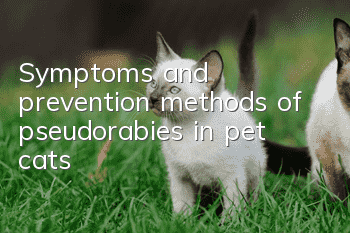Symptoms and prevention methods of pseudorabies in pet cats

Pseudorabies is an acute infectious disease. It was first discovered in the United States and was later isolated and reported by Hungarian scholars. Because its clinical symptoms are similar to rabies, it was once mistaken for rabies, so the term pseudorabies was later used. to name. In recent years, the disease has been rampant in areas where the pig industry is developed in my country, and has spread to cities and towns through vectors such as birds and rats. This disease is susceptible to cats, has a high mortality rate, and is not easy to cure. Sufficient attention should also be paid to the daily feeding of cats.
Pseudorabies infects a wide range of animals. Generally, pigs, cattle, sheep, etc. are susceptible to infection. Dogs, cats, and rabbits are also susceptible to the disease. Its clinical symptoms are similar to rabies, and we can better understand this disease through the indicators of dog rabies. The main symptoms of pseudorabies are neurological symptoms. In the early stage of the disease, cats with usually docile temperaments suddenly attack humans, resist touch, become restless, extremely excited, and have a constant mental state. Or lethargy and extreme depression. The symptoms develop rapidly in the next few days, and the cat will develop symptoms such as nausea, vomiting, drooling at the corners of the mouth, or barking without purpose. In the later stages of the disease, neurological symptoms are very severe, such as hypersensitivity, often scratching or rubbing the face with claws, extreme itching all over the body, and frantically biting the itchy parts of the body.
Of course, there are also atypical pseudorabies symptoms. Atypical feline pseudorabies symptoms lack some typical self-biting and itching symptoms. They are mainly symptoms of depression, weakness, swallowing, etc., but for example, cat rhythm Sexual tail wagging and facial muscle twitching are symptoms that can be seen in feline pseudorabies.
Cats can also become latent carriers of pseudorabies virus, that is, cats carry pseudorabies virus but do not become ill. Cats with latent pseudorabies virus often affect their puppies, such as female cats infected with pseudorabies virus. After giving birth to cubs, symptoms such as protruding eyes and uneven pupils can be seen, which is also one of the signs of pseudorabies.
The main thing to prevent and control pseudorabies is to cut off its source of infection. In nature, pigs and rodents are the main hosts of pseudorabies virus and the main source of infection. Therefore, cats are generally not allowed to go for a walk in the countryside near pig farms. , and do not let cats drink water from these places. In the process of raising cats, you should pay attention to the hygienic conditions around the cats, keep them neat and clean, and avoid animals that are the source of epidemics such as mice. It should be noted that birds may also be carriers of pseudorabies virus, so they are generally prohibited. Contact between cats and some wild birds. Secondly, in terms of diet, do not feed raw pork, poorly processed pork, or diseased pork to cats.
Cats and dogs do not transmit pseudorabies to each other, and pseudorabies virus does not infect humans. Therefore, if there are pets with pseudorabies symptoms around, there is no need to panic.
- A cat will die if it urinates for a few days
- Should you deworm yourself or go to a pet store?
- Are cat teasers harmful to cats?
- What should I do if my cat suffers from chronic gingivitis?
- Cat's nails are cracked with a thin layer
- Cats go crazy after eating mutton
- What does cat moss on a cat’s chin look like?
- Can cats reproduce after abdominal transmission is cured?
- What exactly is the sterilization shot for female cats?
- Can I still eat unopened cat food if it has expired?



